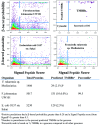TMBB-DB: a transmembrane β-barrel proteome database
- PMID: 22843985
- PMCID: PMC3463127
- DOI: 10.1093/bioinformatics/bts478
TMBB-DB: a transmembrane β-barrel proteome database
Abstract
Motivation: We previously reported the development of a highly accurate statistical algorithm for identifying β-barrel outer membrane proteins or transmembrane β-barrels (TMBBs), from genomic sequence data of Gram-negative bacteria (Freeman,T.C. and Wimley,W.C. (2010) Bioinformatics, 26, 1965-1974). We have now applied this identification algorithm to all available Gram-negative bacterial genomes (over 600 chromosomes) and have constructed a publicly available, searchable, up-to-date, database of all proteins in these genomes.
Results: For each protein in the database, there is information on (i) β-barrel membrane protein probability for identification of β-barrels, (ii) β-strand and β-hairpin propensity for structure and topology prediction, (iii) signal sequence score because most TMBBs are secreted through the inner membrane translocon and, thus, have a signal sequence, and (iv) transmembrane α-helix predictions, for reducing false positive predictions. This information is sufficient for the accurate identification of most β-barrel membrane proteins in these genomes. In the database there are nearly 50 000 predicted TMBBs (out of 1.9 million total putative proteins). Of those, more than 15 000 are 'hypothetical' or 'putative' proteins, not previously identified as TMBBs. This wealth of genomic information is not available anywhere else.
Availability: The TMBB genomic database is available at http://beta-barrel.tulane.edu/.
Contact: wwimley@tulane.edu.
Figures





Similar articles
-
A highly accurate statistical approach for the prediction of transmembrane beta-barrels.Bioinformatics. 2010 Aug 15;26(16):1965-74. doi: 10.1093/bioinformatics/btq308. Epub 2010 Jun 10. Bioinformatics. 2010. PMID: 20538726 Free PMC article.
-
General features of transmembrane beta barrels from a large database.Proc Natl Acad Sci U S A. 2023 Jul 18;120(29):e2220762120. doi: 10.1073/pnas.2220762120. Epub 2023 Jul 11. Proc Natl Acad Sci U S A. 2023. PMID: 37432995 Free PMC article.
-
BetAware-Deep: An Accurate Web Server for Discrimination and Topology Prediction of Prokaryotic Transmembrane β-barrel Proteins.J Mol Biol. 2021 May 28;433(11):166729. doi: 10.1016/j.jmb.2020.166729. Epub 2020 Dec 3. J Mol Biol. 2021. PMID: 33972021
-
Topology of membrane proteins-predictions, limitations and variations.Curr Opin Struct Biol. 2018 Jun;50:9-17. doi: 10.1016/j.sbi.2017.10.003. Epub 2017 Nov 5. Curr Opin Struct Biol. 2018. PMID: 29100082 Review.
-
Current developments on beta-barrel membrane proteins: sequence and structure analysis, discrimination and prediction.Curr Protein Pept Sci. 2007 Dec;8(6):580-99. doi: 10.2174/138920307783018712. Curr Protein Pept Sci. 2007. PMID: 18220845 Review.
Cited by
-
All-atom 3D structure prediction of transmembrane β-barrel proteins from sequences.Proc Natl Acad Sci U S A. 2015 Apr 28;112(17):5413-8. doi: 10.1073/pnas.1419956112. Epub 2015 Apr 9. Proc Natl Acad Sci U S A. 2015. PMID: 25858953 Free PMC article.
-
The Treponema pallidum Outer Membrane.Curr Top Microbiol Immunol. 2018;415:1-38. doi: 10.1007/82_2017_44. Curr Top Microbiol Immunol. 2018. PMID: 28849315 Free PMC article. Review.
-
Colicin E1 opens its hinge to plug TolC.Elife. 2022 Feb 24;11:e73297. doi: 10.7554/eLife.73297. Elife. 2022. PMID: 35199644 Free PMC article.
-
Identification of Protective Antigens for Vaccination against Systemic Salmonellosis.Front Immunol. 2014 Aug 11;5:381. doi: 10.3389/fimmu.2014.00381. eCollection 2014. Front Immunol. 2014. PMID: 25157252 Free PMC article. Review.
-
ccPDB 2.0: an updated version of datasets created and compiled from Protein Data Bank.Database (Oxford). 2019 Jan 1;2019:bay142. doi: 10.1093/database/bay142. Database (Oxford). 2019. PMID: 30689843 Free PMC article.
References
Publication types
MeSH terms
Substances
Grants and funding
LinkOut - more resources
Full Text Sources
Miscellaneous

